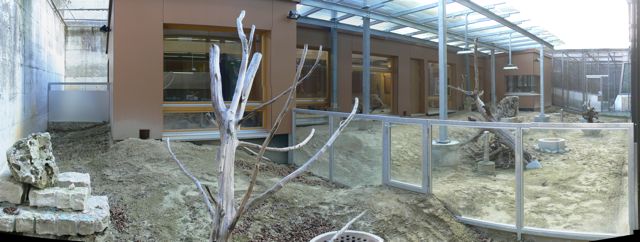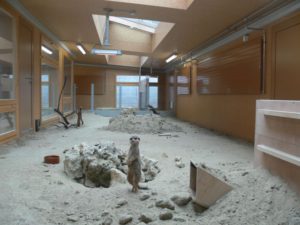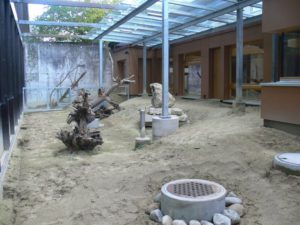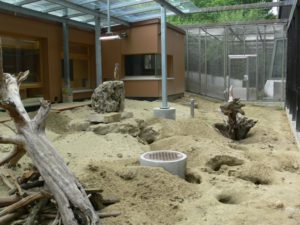The Zurich enclosure is a research facility – yet designed on principles that base on 18 years of meerkat observations combined with experience from meerkat keepers in several zoos. It intends to provide space for one meerkat group; according to Swiss regulations on animal welfare, the enclosure is spacious enough to hold 30 meerkats. However, the enclosure is also designed to accommodate species-specific behaviour that is as close as possible to natural conditions. For example:
- The entire enclosure is filled with sand to allow for digging.
- It contains logs and elevated spaces for sentinel behaviour; the inside area has ceiling windows.
- There are three artificial burrows in the enclosure for the meerkats to rest and hide.
- There are 5 heat lamps available for meerkats to keep warm also in winter.
- The layout allows the separation of evicted females from the group while the dominant female is pregnant, thus reducing stress levels for the females and the group.
- The chip-operated cat flaps between the indoor and outdoor areas allow for further separation in case this is needed.
General layout
The entire compound measures 266 square meters (approx. 320 square yards), and is divided into five main parts:
- There is an outdoor meerkat area (146 m2) and an indoor meerkat area (60 m2); each area is divided in a smaller and a larger space separated by glass or mesh. As a result, there are four separate, but interconnected, enclosures.
- All meerkat areas are filled with sand – approx. 30 cm indoor and up to 1.5 m outdoor. The sand is of local origin, but is a mix designed after the Kinderzoo Rapperswil meerkat enclosure’s sand; it allows for safe digging, i.e. holes don’t collapse easily. All structures like rocks, trees or burrows are secured so that meerkats can’t dig under them and make them collapse.
- There are three large artificial burrows, at least one in each indoor compartment, encouraging the meerkats to sleep in the house. This adds safety in the – unlikely – case a predator should find its way into the enclosure at night. Each burrow entrance can be blocked, if needed.
- There is a separate work room and holding facility (18 m2) where also meerkat food crickets are bred.
- Indoor area
- Outdoor area
- After 2 months of digging
Observation
The enclosure is not visible from the public campus, yet the outside area can be observed from two sides. The facility is fitted with cameras, including a camera in the main burrow.





